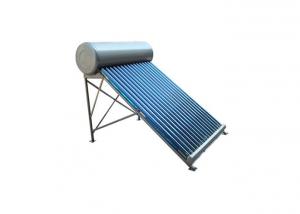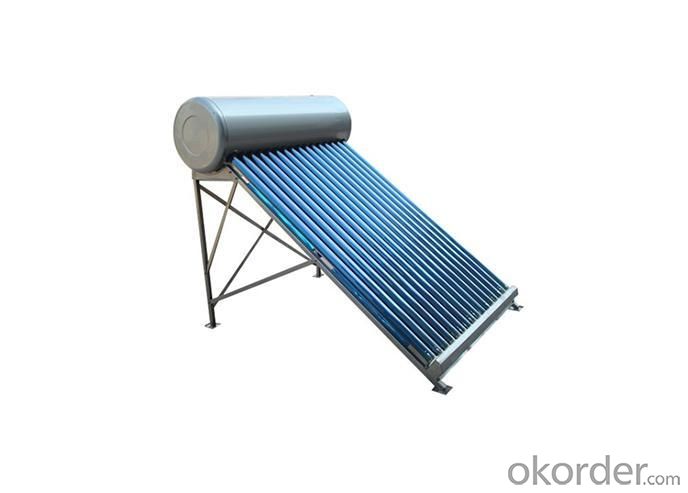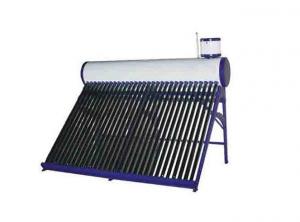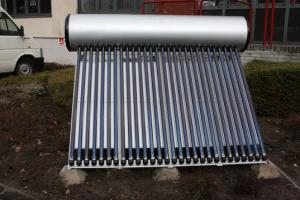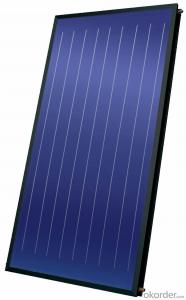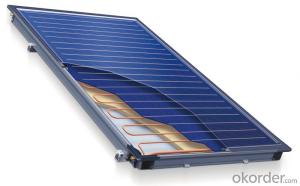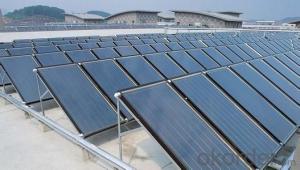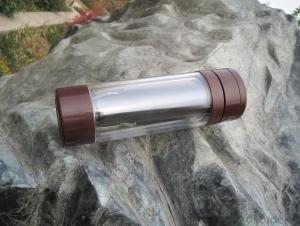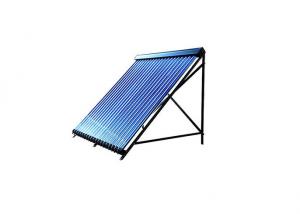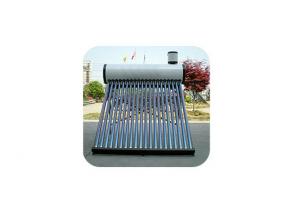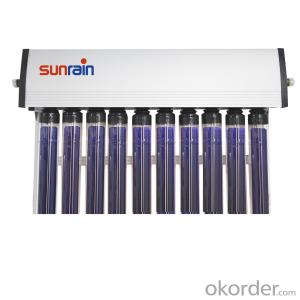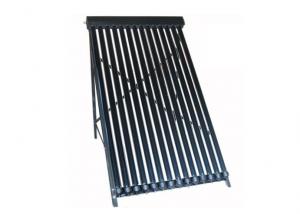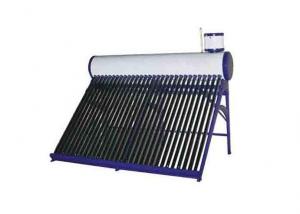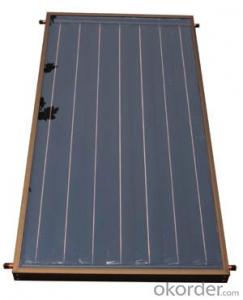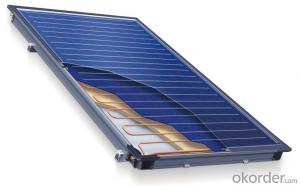Enduro Solar Water Heater
- Loading Port:
- China Main Port
- Payment Terms:
- TT or LC
- Min Order Qty:
- 5 Sets pc
- Supply Capability:
- 60,000 Sets per Year pc/month
OKorder Service Pledge
OKorder Financial Service
You Might Also Like
solar energy water heater,solar heating system,vacuum tube solar water heater:for household,school,enterprise,government,swimmin
Specifications:
1) Tank
a) Outer Tank material: galvanized armor plate.
b) Inner Tank material: imported SUS304-2B food grade stainless steel.
c) Water Tank Diameter: Φ410/420/460/470/480/500/520mm.
d) Insulating layer: 55-60mm polyurethane foame.
e) Tank Capacity: 90/110/150/180/200/210/240/300/350L.
2) Vacuum tube
a) Dimension: Φ47*1500mm/Φ58*1800mm.
b) Material: high boron silicon 3.3 glass.
c) Qty: 16/18/20/24/30/36 pcs.
d) Hail resistance diameter: Φ25mm
e) Tube coating: by AL-N-AL or ALN/AIN-SS/CU.
3) Bracket
a) Material: color armor plate.
b) Thickness: 1.5mm.
c) Obliquity: from 38o to 45o .
4) Certificates: ISO9001:2000,CCC,CE
- Q: Are there any limitations to the size of a solar collector installation?
- Indeed, the size of a solar collector installation is subject to various limitations. One such limitation pertains to the space available for installation. The installation of solar collectors necessitates a certain amount of space, and if the available area is restricted, the installation of a large-scale solar collector system may not be feasible. Another limitation concerns the quantity of sunlight or solar radiation accessible in a specific location. The electricity or heat generation of solar collectors relies on sunlight, so if an area experiences limited sunlight throughout the year, the installation of a large-scale solar collector system may not be practicable. Moreover, the cost associated with the installation and maintenance of a large-scale solar collector system can impose limitations. Larger installations necessitate more equipment, materials, and labor, thereby increasing the overall cost. Furthermore, the cost of maintaining, repairing, and cleaning a larger system may also be higher, potentially constraining the size of the installation. Additionally, limitations may arise from the electrical grid capacity and infrastructure. If the local electrical grid lacks the capacity to accommodate the additional energy generated by a large-scale solar collector system, connecting it to the grid may not be possible. Upgrading the grid infrastructure can be both costly and time-consuming, thereby restricting the size of the installation. Lastly, regulatory and zoning restrictions can also impact the size of a solar collector installation. Local regulations and zoning laws may impose constraints on the size or height of solar collector installations, thereby limiting their scale. In summary, while solar collector installations can be expanded to a certain extent, factors such as available space, sunlight availability, cost, electrical grid capacity, and regulatory constraints can impose limitations on their size.
- Q: Can solar collectors be used for generating electricity at night?
- No, solar collectors cannot generate electricity at night as they rely on sunlight to produce electricity.
- Q: Can solar collectors be used in areas with limited access to storage solutions?
- Yes, solar collectors can be used in areas with limited access to storage solutions. Solar collectors primarily generate electricity when the sun is shining, which can be directly used for immediate energy needs in such areas. While storage solutions like batteries are typically used to store excess energy for later use, the absence of storage options does not prevent the direct use of solar energy as long as there is sunlight available.
- Q: How do solar collectors affect the carbon footprint of a building?
- Solar collectors can significantly reduce the carbon footprint of a building by harnessing renewable energy from the sun. By generating clean and sustainable electricity, solar collectors eliminate the need for fossil fuel-based power sources, which are major contributors to greenhouse gas emissions. Thus, the integration of solar collectors helps to decrease the carbon emissions associated with a building's energy consumption, making it more environmentally friendly and reducing its overall carbon footprint.
- Q: How do solar collectors compare to traditional heating methods in terms of efficiency?
- Solar collectors are generally more efficient than traditional heating methods in terms of energy conversion. Traditional heating methods, such as fossil fuel-based systems, rely on burning fuels to generate heat, which leads to energy losses in the form of combustion byproducts. On the other hand, solar collectors harness the power of the sun to directly convert sunlight into heat energy, minimizing energy losses in the process. This makes solar collectors more efficient in terms of energy conversion. Moreover, solar collectors can also be more efficient in terms of cost. While traditional heating methods require ongoing fuel purchases, solar energy is free and abundant, which reduces long-term costs. Additionally, solar collectors require less maintenance compared to traditional heating systems, further lowering operational costs. It is worth noting that the efficiency of solar collectors can be influenced by various factors, such as the size and orientation of the collector, the level of insulation, and the climate conditions. However, advancements in solar technology have significantly improved the efficiency of solar collectors over the years, making them an increasingly viable and efficient alternative to traditional heating methods.
- Q: What is the size of a typical solar collector?
- The size of a typical solar collector can vary depending on the specific application and design. However, a common size for a residential solar collector is around 2 meters by 1.2 meters, or approximately 6.5 feet by 4 feet.
- Q: What is the lifespan of the components in a solar collector?
- The lifespan of the components in a solar collector can vary depending on various factors such as the quality of the materials used, proper maintenance and care, and environmental conditions. Typically, the key components of a solar collector include the solar panels, heat exchanger, pump, and controller. Solar panels, which are responsible for capturing sunlight and converting it into usable energy, generally have a lifespan of 20 to 25 years. However, with advancements in technology and improved manufacturing processes, some high-quality solar panels can last even longer, up to 30 years or more. It is important to note that the efficiency of solar panels may degrade over time, resulting in slightly reduced energy output. The heat exchanger, which transfers the heat captured by the solar panels to the desired medium (such as water or air), can typically last between 10 to 20 years. Again, the lifespan may vary based on the quality of the material used and regular maintenance. The pump, responsible for circulating the heat-transfer fluid through the system, generally has a lifespan of around 10 to 15 years. Regular maintenance, such as cleaning and lubrication, can help prolong its lifespan. The controller, which regulates the operation of the solar collector system, can last for 10 to 15 years or more. However, technological advancements and updates may require replacing the controller during the lifespan of the system. It is important to note that these estimates are general guidelines and actual lifespans may vary. Regular maintenance, including cleaning the panels, inspecting for any damage or wear, and addressing any issues promptly, can help extend the lifespan of the components in a solar collector. Additionally, choosing high-quality components from reputable manufacturers can also contribute to a longer lifespan.
- Q: Can solar collectors be used in commercial areas?
- Yes, solar collectors can be used in commercial areas. In fact, many businesses are increasingly using solar collectors to harness the power of the sun for their energy needs. Solar collectors, such as solar panels or solar thermal systems, can be installed on rooftops, parking lots, or any available open space in commercial areas. These collectors convert sunlight into electricity or heat, which can be used for various purposes, including powering lighting systems, heating water, or even running entire commercial operations. Using solar collectors in commercial areas not only helps reduce electricity bills and dependency on fossil fuels but also provides businesses with an opportunity to contribute to sustainability efforts and enhance their green image. Additionally, government incentives and tax credits for renewable energy installations often make it financially viable for businesses to invest in solar collectors. Therefore, solar collectors are a viable and beneficial option for commercial areas looking to adopt clean and renewable energy solutions.
- Q: Can solar collectors be used for waste heat recovery?
- Yes, solar collectors can be used for waste heat recovery. Solar collectors are designed to absorb sunlight and convert it into heat energy, which can then be used for various applications such as heating water, generating electricity, or in this case, recovering waste heat. By capturing and utilizing waste heat, solar collectors can help improve energy efficiency and reduce the overall environmental impact of industrial processes or other heat-intensive activities.
- Q: Can solar collectors be used in areas with limited access to technical standards?
- Yes, solar collectors can be used in areas with limited access to technical standards. Solar collectors are relatively simple and straightforward in design and operation. They do not require complex technical standards for installation or maintenance. In fact, solar collectors can often be easily installed and maintained by local communities with basic technical knowledge and training. This makes them a viable and sustainable option for generating clean energy in areas with limited access to technical standards.
1. Manufacturer Overview
| Location | Zhejiang,China |
| Year Established | 2005 |
| Annual Output Value | US$2.5 Million - US$5 Million |
| Main Markets | North America South America Eastern Europe Southeast Asia Africa Oceania Mid East Eastern Asia Western Europe Central America Northern Europe Southern Europe Domestic Market |
| Company Certifications | ISO9001:2008;ISO14001:2004 |
2. Manufacturer Certificates
| a) Certification Name | |
| Range | |
| Reference | |
| Validity Period |
3. Manufacturer Capability
| a) Trade Capacity | |
| Nearest Port | Shanghai,Hangzhou |
| Export Percentage | 41% - 50% |
| No.of Employees in Trade Department | 6-10 People |
| Language Spoken: | English, Chinese |
| b) Factory Information | |
| Factory Size: | 5,000-10,000 square meters |
| No. of Production Lines | 5 |
| Contract Manufacturing | OEM Service Offered Design Service Offered Buyer Label Offered |
| Product Price Range | Average |
Send your message to us
Enduro Solar Water Heater
- Loading Port:
- China Main Port
- Payment Terms:
- TT or LC
- Min Order Qty:
- 5 Sets pc
- Supply Capability:
- 60,000 Sets per Year pc/month
OKorder Service Pledge
OKorder Financial Service
Similar products
Hot products
Hot Searches
Related keywords
